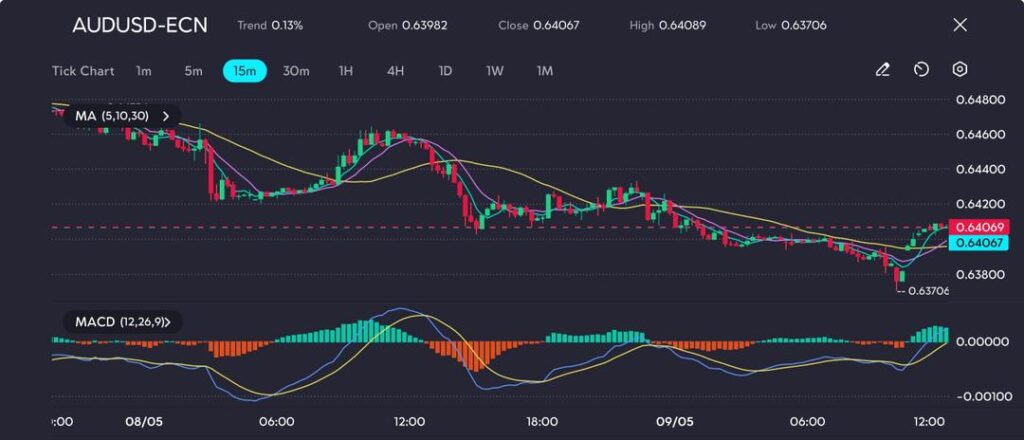The Australian dollar, being commodity-linked by nature, received some strength with the Chinese exports rose 8.1% in April year-on-year, climbing to 0.6407 on Friday. Still, the AUDUSD pair remains poised for a 0.7% weekly decline, snapping a four-week winning streak amid shifting interest rate expectations and renewed U.S. dollar strength.
On the other hand, the New Zealand Dollar also slipped, falling 0.2% to 0.5892, extending its weekly decline to 0.9%. A break below 0.5894 marks a bearish signal, though support lingers near the 200-day moving average at 0.5882.
AUDUSD drifted lower throughout the session, touching a low of 0.63706 before staging a modest rebound. The MACD histogram has flipped into bullish territory, with a fresh crossover just as the price began reclaiming ground above the 5- and 10-period moving averages. The short-term recovery appears constructive, but overhead pressure remains near 0.64100–0.64200, where the 30-period moving average and prior support-turned-resistance converge.

Picture: AUDUSD bounces from 0.6370 low with MACD turning bullish, but 0.6420 remains key near-term hurdle, seen on the VT Markets app
For bulls to gain meaningful traction, the pair needs to break and hold above 0.64200, otherwise this may be a corrective bounce within a broader downtrend. A drop back below 0.63900 could see momentum reset toward the week’s low.
Behind the scenes, a hawkish tone from the Federal Reserve has scaled back bets on rate cuts this year. Market pricing now implies just 68 basis points of easing in 2025, down from 78 bps a day earlier. This has lifted the dollar across the board, with AUD and NZD underperforming.
President Donald Trump’s trade pivot also drove sentiment. While the Fed held rates steady, Trump’s announcement of a U.S.-UK trade deal and commitment to maintain Chinese tariffs has introduced volatility ahead of the U.S.-China meeting.
As such, rate cut expectations remain firm for the Reserve Bank of Australia, with markets fully pricing a 25bp reduction to 3.85% on May 20. Across the Tasman, the RBNZ is also expected to ease, with Westpac forecasting two cuts this year, citing persistent trade-related headwinds.
The Aussie may continue to hover below 0.6450 ahead of economic data and central bank expectations in this coming week. A downside break below 0.6370 could retest 0.6320, while trade optimism could offer temporary support near 0.6410–0.6425. Traders remain focused on tariff developments and Fed policy cues for direction.
Click here to open account and start trading.